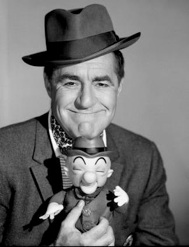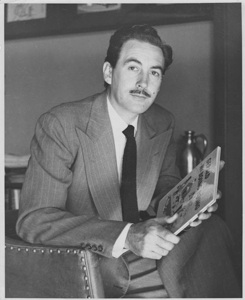
The following represents a small fraction of all the persons who worked at United Productions of America at one time or another. There is an attempt to present a cross-section of jobs and to include individuals of unusual importance.
Babbitt, Arthur (Art) (1907-1992) Animator, Director. A talented animator and a willful union activist, he began his career in New York City and worked at Terrytoons. In 1932, he joined Walt Disney Productions and became an expert on Goofy. Babbitt also contributed to Snow White and the Seven Dwarfs, Pinocchio, and Dumbo. In 1941, he led the Disney Studio strike and was ultimately fired three different times. In 1948, Babbitt joined UPA as an animator. He directed two UPA shorts, Giddyap and The Popcorn Story, and left the studio in 1952. Babbitt co-founded Quartet Films and later worked for Richard Williams's London studio.
Backus, James (Jim) (1913-1989) Voice of Magoo. Perhaps as much as anyone, he was responsible for forming the personality of UPA's best-known character, the nearsighted Quincy Magoo. A native of Cleveland, Backus worked in radio, and his role on The Alan Young Show brought him to Los Angeles. When John Hubley needed a voice for UPA's new character, Jerry Hausner recommended Backus, who proceeded to play Magoo in every single Columbia theatrical short, the feature film 1001 Arabian Nights, three television series, two specials, and countless commercials. His feature-film roles include Rebel without a Cause. Backus is also remembered for playing Thurston Howell III on Gilligan's Island.

Bosustow, Stephen (Steve) (1911-1981) Co-founder, Producer, Executive Producer, President. Born in Canada, he graduated from Lincoln High School in Los Angeles. He worked for animation producers Ub Iwerks and Walter Lantz before joining Walt Disney Productions in 1935. A strike organizer, Bosustow was fired by the studio in 1941. In 1943, he co-founded Industrial Film and Poster Service, which became UPA. After gaining control of the company in 1946, Bosustow served as its head during its award-winning heyday. In 1960, he sold UPA to Henry Saperstein; subsequently, Bosustow formed a new company, Stephen Bosustow Productions, which produced the Oscar-winning short Is It Always Right to Be Right?
Burness, Wilson D. (Pete) (1904-1969) Director, Animator, Producer, Story. In a studio comprised of unpredictable artists, he was the workmanlike professional. He directed thirty-seven of the ninety theatrical cartoons produced for Columbia (more than any other person). After an extensive animation career, including work at M-G-M and Warner Bros., Burness joined UPA as an animator in 1950 and then became Magoo's principal director. He directed two Academy Award winners, When Magoo Flew and Magoo's Puddle Jumper, and the non-Magoo film Pete Hothead, which may be a self-caricature. Burness began work on 1001 Arabian Nights but left before the feature's completion. He subsequently served as a director for Jay Ward.

Cannon, Robert (Bobe) (1909-1964) Animator, Director, Producer, Story. His graceful, childlike, and poetic films are among the most distinctive creations of the Hollywood animation studios. As an animator for Warner Bros., Cannon contributed to The Dover Boys at Pimento University, which points to the modernist UPA style. In 1944, Cannon joined the early incarnation of UPA; he animated A Few Quick Facts about Fear and directed Brotherhood of Man. After a hiatus, he directed Gerald McBoing Boing, which won an Oscar. In collaboration with T. Hee, Cannon created a handful of charming cartoons that epitomize the UPA ideal. Cannon supervised The Boing-Boing Show and left the studio in 1957.

Crippen, Fred (1928-) Animator, Designer, Director. Born in Michigan, he attended Michigan State and served in the Marine Corps before moving to New York City, where he worked for Shamus Culhane Productions and UPA-New York. During a layoff, Crippen earned some money by repainting the UPA studio. In 1955, he was invited to join the Burbank studio and work on The Boing-Boing Show. Crippen animated and/or directed many of the most distinctive pieces on the show, sometimes in collaboration with Ernest Pintoff, Jimmy Murakami, and John Whitney. In 1958, Crippen left UPA to form Pantomime Pictures, which created television shows and commercials for over fifty years.
Deitch, Gene (1924-) Designer, Director, Creative Director-New York. He learned the animation business at UPA, which he joined as an apprentice designer in 1946. In 1949, he moved to Detroit to work for the Jam Handy Organization. Two years later, Deitch joined UPA-New York, where he eventually served as creative director. He directed Howdy Doody and His Magic Hat, Pump Trouble, and television commercials. Deitch left UPA and soon headed Terrytoons, which he refashioned, briefly, into a UPA-like studio. In 1959, he moved to Prague, fell in love with a Czech woman, and proceeded to live and work there for the next half century.

Dranko, Robert (Bob) (1924-2009) Color, Designer, Director. Quiet and diligent, this California native worked at UPA from 1950 until the 1960s. He served in World War II for three years, three months, and four days (he counted) and studied art at Los Angeles City College and Chouinard. At UPA, his breakthrough was The Unicorn in the Garden. Later, Dranko took charge of the design of the Magoo films. Bosustow said that Dranko's concept art persuaded him to produce 1001 Arabian Nights, and Dranko was named art director. He left the studio but returned to do some freelance work in the 1960s. Thereafter, he worked for Hanna-Barbera.

Dunning, Garnett George (1920-1979) Story, Director. Born in Toronto, he learned from filmmaker Norman McLaren. Dunning was interested in non-traditional forms of animation; he experimented with various media, such as painting on glass. In the 1950s, he joined UPA-New York and directed two pieces for The Boing-Boing Show: "Quiet Town" and "Two by Two." Thereafter, he worked for UPA's London studio and then formed T.V. Cartoons, Ltd. (later known as T.V.A. Cartoons). In the 1960s, he directed episodes of the TV series The Beatles. This led to Dunning's crowning achievement: he directed Yellow Submarine, a phantasmagoric film that combines Rotoscope, computer animation, watercolor, and traditional cel animation.
Eastman, Philip Dey (Phil) (1909-1986) Story. Educated at Amherst College, where his father was a professor of German, Eastman later studied art and worked at Disney's from 1935 to 1941. After the strike, he created storyboards for Leon Schlesinger Productions. Eastman served in the Army Signal Corps from 1943 to 1945 and contributed to the Private Snafu films. At the war's conclusion, he joined the UPA story department. In 1951, he was fired during a purge of suspected Communists. He testified before HUAC in 1953 and moved to Connecticut a year later. Under the name P. D. Eastman, he succeeded as a children's-book author; publications include Are You My Mother?

Engel, Julius (Jules) (1909-2003) Designer, Color. Born in Budapest, Hungary, he never lost his distinctive accent. He immigrated to Illinois in the 1930s and found his way to California, where he worked for Charles Mintz and Walt Disney. From 1942 to 1945, Engel served in the Army's First Motion Picture Unit. In 1945, he joined UPA and worked in the background department under Herbert Klynn. When Klynn was promoted to management, Engel took charge of the department. In particular, Engel painted backgrounds for many of Bobe Cannon's films, including Madeline. Engel left UPA in 1959 for Klynn's Format Films. In the 1960s, Engel founded the Experimental Animation Program at CalArts.

More to come.... Check back in the future for the rest of the alphabet!
Some of the content above is printed by permission of Turner Classic Movies.
